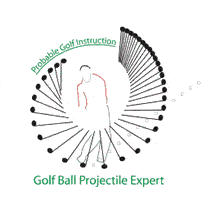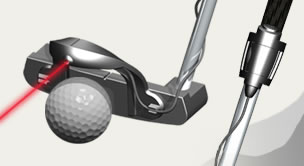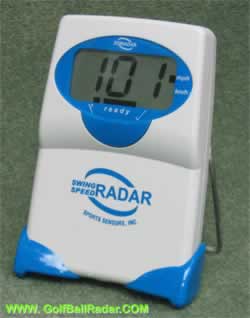
|
|
|
Golf Playing LessonsFrom this page, you can access playing lessons for various parts of the game. Click on the topics below and you'll be taken to the appropriate place in the website. Look below the navigation menu (the one below this sentence) for the specific page's content.
Golf Alignment -- Small Errors Magnified
For instance, an error in alignment of ONE degree on a 200 yard shot results in an error of 3.5 yards. An error in alignment of FIVE degrees results in an error of 17 yards (that's the width of some greens). That's a huge error!! Misalign by 5 degrees on a 20 foot putt creates an error of 21 inches at the hole. If you can't align properly, how can you ever hit your target?? The vast majority of right handed swingers align too far to the right. Likewise the vast majority of left handed swingers align too far to the left. Since the object is always to hit the ball towards the hole, these golfers have unconsciously modified their swings, to the best of their abilities, to get the ball on line even though they're grossly misaligned. They have created extra moves in their swings and putting strokes, making them more complex and ineffective. Most right handed swingers slice the ball. Why? Partially because they use their arms and hands too much, ignoring their lower body and torso. But because they misalign to the right, they have produced an outside to inside swing path to pull the ball towards the left to compensate. The further they misalign right, the more they swing outside to inside. Such a swing is weak (it can't produce high club head speeds) and produces slices that are difficult to control and produce less distance. Imagine trying to learn to shoot a rifle with the sites grossly off. There would be a lot of trial and error but you'd eventually be able to hit your target by holding the rifle in an unorthodox way. It's the same with the golf swing. Improper alignment leads to unorthodox swings. So, how does one align properly? That's the topic of this article. Anytime I go to the driving range, it amazes me how few golfers ensure they are aimed at their targets. With grass tees, very few have clubs placed on the grass to aid their alignment. On artificial mats, the same is true and they don't align the mat so that they are aimed at a specific target.
Here is my recommended process of aligning yourself at your target. 1. Stand about 10 feet behind your ball and visualize your target line from your ball to your target. 2. Pick an intermediate target to aim at 3 to 6 feet in front of your ball which is on the target line. It can be a leaf, discolouration in grass, broken tee, etc. Research has shown that using an intermediate target significantly increases alignment accuracy. CLICK HERE for the research.
This alignment process will still lead to some error but it's minimal. It's important that you practice the process to perfect it. It's some thing you can practice in your home or office. Remember, "practice makes perfect." Or, even more to the point about the importance of accurate alignment, are the five P's: Proper Preparation Prevents Poor Performance Like I shared with you in my last newsletter, you can also practice this process of alignment with the putter, at home on your carpet. I recently tested and evaluated a Laser Putting Alignment Device and found it extremely helpful. I've always been told by some players that I tend to "cut" my putts a bit, which means my putter face is open slightly at impact. After attaching the laser device to my putter and aiming the putter at a target, I discovered that I consistently aim the putter face slightly left of the target. To compensate, I open the face slightly during the stroke and cut the putt.
After only a few days of practicing my alignment with the laser device attached, I am now squaring the putter face to my target consistently. I can now practice making a proper stroke confident that I am aimed at my target. I am missing my putts a little right now, but am confident that I will "cure" my cut stroke. Take a look at the Laser Putting Device that I use and consider getting one for yourself Order yours TODAY! Only $49.95 If you'd like some help with your mental game, fellow Canadain, Lisa Brown is a mental toughness coach for National and Olympic athletes, and she has written some excellent ebooks. Click HERE to take a look. If you have any other great ideas of why or how to use new golf technology to improve, please share them with me and I'll include them in the next newsletter. Submit your suggestions HERE .
Golf Alignment -- Improved PuttingHow often do you two putt from 60 feet? If you're like most golfers, probably not very often. To do so, you need to get your first putt inside 6 feet to have a 50% chance. Even the Tour Pro only sinks about 60% of his 6 foot putts. TAP HERE to look at a graph of Putting Percentages. Most golfers don't align the putter face accurately towards their target. CLICK HERE for the research. To get a 60 foot putt down in two strokes, the golfer must do the following: 1. Read the putt correctly so that the amount of break is predicted accurately. CLICK HERE to learn how to read putts. It's actually quite a complex task. Many have said that putting is the simplest part of the game and the easiest to learn proficiency. I beg to differ. If this was the case, then there'd be many more very good putters. Becoming a good putter requires a tremendous amount of coordination. Misalign by 5 degrees on a 60 foot putt creates an error of 5.3 feet at the hole; and, that's if you get the distance right. Since the golfer instinctively responds to feedback from the shot, consistently misaligning leads to modifying the stroke. Most right handed golfers misalign to the right. Consistently hitting the ball right of the target will lead to modifying the stroke to pull the ball to the left. If you look at most right handed golfers full swings and putting strokes, you'll find that they pull across the ball. The path of the club is to the left of where the face of the club is aimed. Thus, there are a lot of "cut" shots out there (fades and slices on long shots, and errant putts). To improve your stroke, you need proper feedback. It's essential that you practice your putting with the aid of alignment aids, the simplest of which are golf clubs laying on the putting green along your intended target line.
You can practice your alignment all winter long in the comfort of your home. I highly recommend doing this. The more you practice proper alignment, the better you'll become. Remember, "practice makes perfect." Or, even more to the point about the importance of accurate alignment, are the five P's: Proper Preparation Prevents Poor Performance Take a look at the Laser Putting Device that I use and consider getting one for yourself Order yours TODAY! Only $49.95 Golf Alignment -- Swing Path and Solid ContactFor those in the north, golf season is all but over. For those of you that are still playing, there is less time to play due to significantly fewer daylight hours (more for those of you in the southern hemisphere). Calculate how many hours of daylight in your area by using my new sunrise/sunset calculator. Tap HERE for the calculator. As I've reiterated in my newsletters, proper alignment is essential to play well. Research studies have shown that the vast majority of amateur golfers misalign which causes swing faults, poor ball striking and errant golf shots. Below, I'll outline how proper alignment can help produce maximum clubhead speed and solid contact. It's all a result of the optimum club head swing path, which a proper alignment can facilitate. With the off season upon us, what a perfect opportunity to work on the alignment aspect of the game. You can do so without hitting a golf ball. You can do it in the comfort of your home or office. The proper alignment process can be learned through consistent practice. Taking a club and aligning yourself a couple of times a day will go a long ways towards your golf game improvement. Whether there's a commercial break on TV or you need a change of pace from the task at hand, take 15 minutes or so each day to do the following: 1. Pick up a club and go through the alignment process. At the very least, gripping the club will keep your hands familiar with the club during the off season. The more times you practice your alignment, the more "automatic" the process will become. I'd use a 5-iron (medium length club) as well as a putter. 2. You can even attach a laser putting device to the face of your iron. Because of the loft of the iron, the laser will point higher but it will indicate the direction the club face is pointing. You can monitor your progress by keeping track of how close to your target you're aiming. Can you aim the club face within a few inches of your target (that can be the middle of a painting on a wall or a corner in the room)? 3. Either before or after practicing your alignment, do some stretches and some sit-ups. Increasing your flexibility and mid-section strength will enable you to increase your club head speed. For an excellent total golf fitness program, I'd recommend this DVD collection. So, how does poor alignment lead to poor ball striking? Well, not aligning properly will force you to make compensations in your swing to get the ball flying towards the target. Most golfers align right of their targets, thus most golf balls miss right of their targets. You body will unconsciously adjust over time and you'll begin to swing the club outside-to-inside the target line. Such a club head path decreases maximum club head speed and solid contact. In order to make solid contact with the ball with maximum club head speed, the optimum club head path is inside-to-along the target line-to-inside, which is depicted in the diagram to the right below. Most amateurs swing outside-to-inside like the first diagram on the left below. A minority of players swing from inside-to-outside like the last diagram below (not ideal but much better than the outside-to-inside path).
Swinging the club from the inside to along the target line to the inside gives the club the best chance of hitting the ball on the center of the club face with maximum speed. Misaligning from the beginning will encourage the golfer to modify his/her swing path to get the ball on target. Below are the results of some testing done by Golf Digest on hitting the "sweet spot" which demonstrates the consequences of not hitting the ball solidly; you fall short of your target. During the test, a 6-iron was hit eight times on each of 13 different points on the clubface. The points included five vertical rows centered on the center line of the scored area of the clubface and three horizontal rows separated by one-quarter inch with the first row beginning one-half inch above the sole. A total of 104 shots were hit with each iron, and the totals were combined to produce a composite result.
The more you practice proper alignment, the better you'll become. Take the time this winter to practice the alignment process so it will be automatic by next season. Proper alignment promotes the optimum swing path and the greatest chance of solid contact with maximum speed. Remember, "practice makes perfect." Or, even more to the point about the importance of accurate alignment, are the five P's: Proper Preparation Prevents Poor Performance
What tempo do you swing the club with? Research has shown that all the best players, past and present, swing with one of three tempos. Unlock yours and start striking the ball better TODAY! Use coupon PGOLF for 10% off. Click HERE to unlock your ideal TEMPO! If you have any questions or comments, feel free to email me at golfexpert@probablegolfinstruction.com ©Probable Golf Instruction, Ken Tannar 2001-2011. All Rights Reserved. Langley, B.C. V2Y 2G4Phone: 604-539-7760 FAX: to fax, email an attachment probablegolf@yahoo.ca or golfexpert@probablegolfinstruction.com |
| GOLF SOFTWARE |
|
Power Meter measures Swing Speed
|
| GOLF NEWS |
|
| GOLF NEWSLETTER |
Statistics
·Putting
·Long Balls
·Games
·Handicap
·Scoring
·Shot Patterns
·Tournaments
·Tours
Pro Shop
·Ball Marker Engraved
·Books
·CDs & DVDs
·Green Reader
·Impact Labels
·Laser Rangefinder
·Longer Drives
·Products
·Teaching Aids
|
Subscribe to the Probable Golf Newsletter
and
|
| GOLF POLL |
The 19th Hole
·Advertising
·Ask the Golf Expert
·Consultation/Litigation
·FAQs
·Golf Blog
·Golf Draws
·Links
·Science of Golf
·Tell a Friend
·Testimonials
·

Golf Ball Finder Glasses
·
| GOLF CARTOON |
















